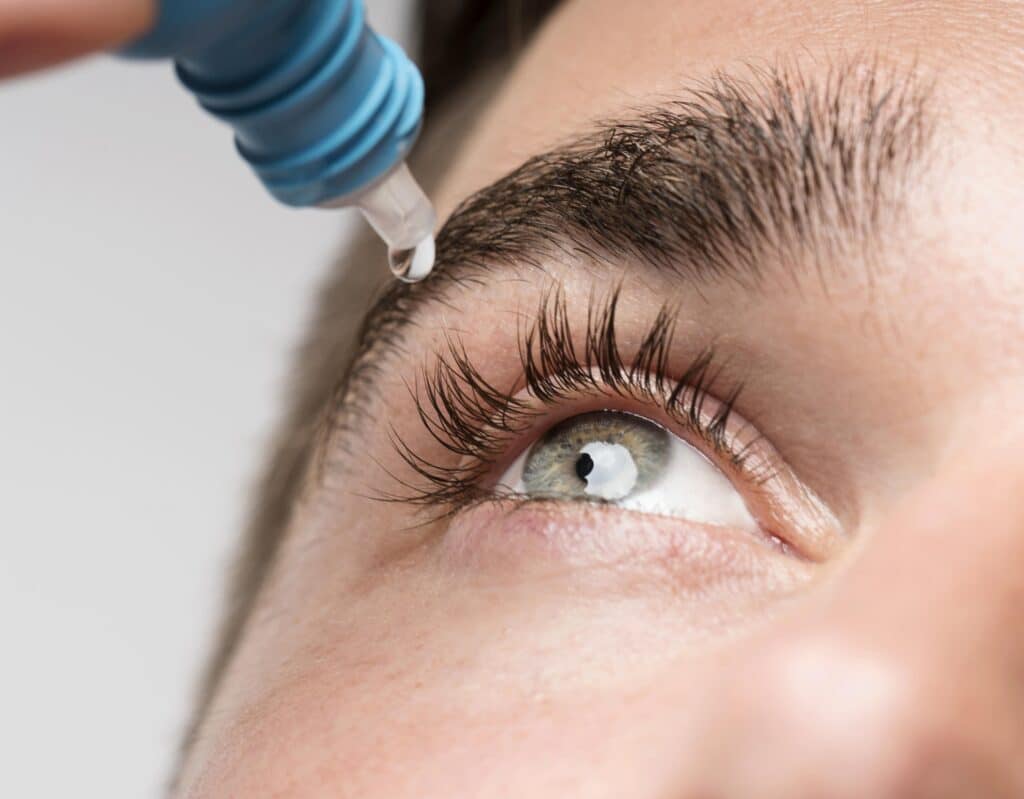Azopt Eye Drops is a prescription medication used to treat high pressure inside the eye. It contains brinzolamide, categorized as a carbonic anhydrase inhibitor. The medication works by reducing the amount of fluid produced in the eye. It helps to lower the intraocular pressure (IOP). High IOP can damage the optic nerve and lead to glaucoma, a serious condition that can result in blindness if left untreated.
These are effective in treating ocular hypertension and open-angle glaucoma. These conditions are characterized by increased IOP. The drops are an alternative for patients who cannot tolerate beta-blockers or prostaglandin analogs. The two classes of drugs used to treat glaucoma. It is available in a 1% solution easy to apply to the eye.
The medication consider useful only if prescribed by a healthcare provider. A single drop instilled in the affected eye(s) three times a day. Patients should not use more drops than directed, as this can increase the risk of side effects. Common side effects of Azopt Drops for Eyes include stinging or burning of the eyes, blurred vision, and dry eyes. If any of these symptoms persist or worsen, patients should contact their healthcare provider.
These Eye Drops are a safe and effective medication for treating ocular hypertension. Also, it helps in the treatment of open-angle glaucoma. The drops work by reducing the production of fluid in the eye, which helps to lower intraocular pressure. With proper use as directed, patients can experience relief from symptoms while minimizing the risk of side effects.
What Are Azopt Eye Droplets?
The eye drops are a prescription medication help to lower the pressure inside the eye. It is for the patients facing issues of open-angle glaucoma or ocular hypertension. These eye drops come in the form of a liquid solution applied to the eye using a dropper.
The active ingredient in these eye drops is brinzolamide. It belongs to a class of medications called carbonic anhydrase inhibitors. This drug works by reducing the amount of fluid produced in the eye. It helps to reduce the pressure inside the eye.
What is Azopt Eye Drops used for?
It helps to treat open-angle glaucoma or ocular hypertension. Open-angle glaucoma is a condition in which the optic nerve gets damaged due to increased pressure inside the eye. This condition can cause vision loss, and if left untreated, can lead to blindness. Ocular hypertension is a condition in which the pressure inside the eye is higher than normal, but there is no damage to the optic nerve.
They are used to lower the pressure inside the eye, which helps to reduce the risk of damage to the optic nerve and prevent vision loss. This medication is usually used in conjunction with other medications that also lower intraocular pressure.
How To Use Azopt Droplets for Eyes?
These eye drops are typically administered twice a day, or as prescribed by your doctor. To use the medication, first wash your hands thoroughly. Then, tilt your head back and pull down your lower eyelid to create a small pocket. Hold the dropper over your eye and squeeze the prescribed number of drops into the pocket created by your lower eyelid.
Close your eyes for one to two minutes after administering the medication to allow the liquid to evenly distribute across the surface of the eye. If you need to use other eye drops as well, leave a five-minute interval between each medication.
What Are The Possible Azopt Eye Drops side effects?
Like all medications, Azopt Eye Drops Side Effects are possible. Some of the most common side effects include:
– Blurred vision
– Burning, stinging, or itching of the eye
– Redness or swelling of the eyelid
– Dry eyes
– Dizziness
– Numbness or tingling in the hands or feet
– Skin rash or itching
More serious side effects can also occur, such as severe eye pain, cloudy vision, or vision changes. If you experience any of these side effects or have any concerns, contact your doctor immediately.
Why is Azopt so expensive?
The Azopt Eye Droplets help in lowering intraocular pressure in conditions like glaucoma but tend to be expensive due to factors such as research and development costs, limited market competition, specialized nature, and the absence of generic alternatives. Additionally, its brand status and patent protection contribute to the higher cost.
What Are The Precautions Before Using Azopt Eye Droplets?
Before using these eye drops, inform your doctor if you have a history of any of the following conditions:
– Kidney disease
– Liver disease
– Respiratory disease, such as asthma or chronic obstructive pulmonary disease (COPD)
– Diabetes
– Allergies
It is also important to inform your doctor of any medications you are currently taking, including over-the-counter medications and supplements. Some medications can interact including other carbonic anhydrase inhibitors and some medications used to treat high blood pressure.
How Long Can You Use Azopt Eyes Drop?
The length of time that you can use Azopt eyes drop will depend on your specific condition and the severity of your symptoms. Your doctor will determine a recommended timeframe for the use of the medication based on your situation. It is important to follow your doctor’s recommendations and not use the medication for longer than prescribed.
Is Azopt Drops for Eyes A Steroid?
No, the eye drops are not a steroid. The active ingredient is brinzolamide, which belongs to a class of medications called carbonic anhydrase inhibitors. These medications work by reducing the amount of fluid produced in the eye, which helps to lower intraocular pressure.
How Does Azopt Eye Drop Work?
It works by decreasing the production of fluid inside the eye, which helps to lower the pressure inside the eye. The active ingredient brinzolamide, works by blocking the action of an enzyme called carbonic anhydrase, which is involved in the production of fluid in the eye.
Reducing the production of fluid in the eye, helps to lower intraocular pressure and reduce the risk of damage to the optic nerve.
Can Azopt Eyes Drop Be Used During Pregnancy?
It is not known whether these eye drops are safe to use during pregnancy. If you are pregnant or planning to become pregnant, it is important to inform your doctor before using the eye drops.
Can Azopt Eye Droplets Cause Headaches?
Headache is a possible side effect. If you experience a headache after using it, contact your doctor. They can help determine if the headache is related to the medication and recommend ways to manage the headache.
What Should You Do If You Miss A Dose Of Azopt Eyes Drop?
If you miss a dose, use the missed dose as soon as possible. However, if it is almost time for your next dose, skip the missed dose and continue with your regular dosing schedule. Do not use a double dose to make up for a missed dose.
Is A Prescription Needed For Azopt Drops for the eyes?
Yes, a prescription is required. These are a prescription medication used to treat open-angle glaucoma or ocular hypertension and are not available over-the-counter.
Can Azopt Eye Droplets Be Used To Treat Glaucoma?
Yes, it can be used to treat open-angle glaucoma. This medication is used to help lower intraocular pressure, which can help to prevent damage to the optic nerve and preserve vision.
Is Azopt Eye Droplets A Beta Blocker?
No, these are not a beta blocker. The active ingredient is brinzolamide, which belongs to a class of medications called carbonic anhydrase inhibitors. These medications work by reducing the production of fluid in the eye, which helps to lower intraocular pressure. Beta-blockers are a different class of medications used to treat high blood pressure and other conditions.
Conclusion
In conclusion, Azopt Eye Drops is a useful medication for managing the elevated intraocular pressure that is often associated with open-angle glaucoma and ocular hypertension. The active ingredient Brinzolamide is a carbonic anhydrase inhibitor that helps to reduce the production of aqueous humor in the eye, thereby decreasing intraocular pressure.
Clinical studies have shown that it is effective in lowering intraocular pressure and maintaining it at safe levels, which can prevent or delay the progression of glaucoma and preserve vision. The medication is usually well-tolerated, with side effects reported in a small percentage of patients.
It is essential to follow the instructions for use carefully, including the frequency and dosage of drops, as well as any precautions and potential adverse effects. Patients with pre-existing conditions or taking other medications should consult with their doctor before using.
Overall, these drops offer a safe and effective treatment option for managing the intraocular pressure associated with glaucoma and ocular hypertension, helping to maintain vision and improve the quality of life for those affected by these serious eye conditions.



